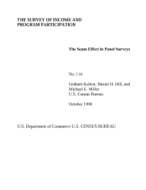The Seam Effect in Panel Surveys
The Seam Effect in Panel Surveys
Working Paper Number: SIPP-WP-116
This paper is concerned with a type of measurement error encountered in panel surveys that has become known as the seam effect. This effect has been found to be pervasive in the Survey of Income and Program Participation, a household panel survey program of the U.S. Bureau of the Census. In order to describe the seam effect it is first necessary to give some basic details of the SIPP design.
Others in Series
Working Paper
Handling Single Wave Nonresponse in a Panel Survey
In cross-sectional surveys, nonresponse is categorized in two ways: unit (total) nonresponse and item nonresponse.
Working Paper
Nonresponse Research for the SIPP
After providing background on the SIPP, this paper discusses the two currently active nonresponse projects mentioned above and plans for extending the research.
Working Paper
The Effects of Being Uninsured on Health Care Service Use
There is growing concern about the number of people in the United States who have no health insurance.
Page Last Revised - October 8, 2021




